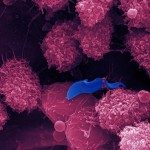A new mechanism to maintain the outer membrane in diderm Firmicutes:
implications for the Gram-negative/Gram-positive transition
Tethering the outer membrane (OM) is crucial for stability of the bacterial cell envelope.
The proposed project aims at elucidating a novel mechanism for OM tethering present in the Negativicutes, a poorly studied clade of the Firmicutes (low-GC Gram-positives), which have the peculiarity of possessing an OM with lipopolysaccharide and a thin peptidoglycan (PG) layer, like Gram-negatives. These bacteria possess atypical characteristics that can inform on novel fundamental mechanisms for the biogenesis and functioning of the bacterial cell envelope.
The selected post-doctoral fellow will use as experimental model the genetically tractable Negativicute Veillonella parvula, a prominent member of the human microbiome, which can behave as an opportunistic pathogen. She/he will characterize the PG of V. parvula and dissect its mechanisms of OM tethering by a combination of bioinformatics and generation of mutants. In parallel, experimental evolution will be used to study the consequences of perturbation of the tethering system on OM stability and PG structure under various stressing conditions both in the wild type and in a recently obtained V. parvula mutant that shows a severe phenotype. These analyses will be complemented by a large-scale evolutionary investigation of this largely understudied system for OM attachment in Bacteria.
Other than the obvious impact in medical research by studying the consequences of OM destabilization on PG homeostasis and fitness, the results obtained in this project will inform on one of the most fundamental transitions in Bacteria, that between Gram-positives and Gram-negatives.
This project is funded by the Labex IBEID and will be done in collaboration with three teams at the Institut Pasteur, Paris with complementary expertise: Gribaldo (Evolution, Phylogenomics), Beloin/Ghigo (Genetics, Cell Surface), Boneca (Peptidoglycan). As such, the postdoctoral fellow will have the opportunity to learn and apply a large range of approaches.
Institut Pasteur is an equal opportunity institution.
Please send a motivation letter, a CV, and the names of two referees to simonetta.gribaldo(at)pasteur.fr
Selected literature
-Antunes, L.C., Poppleton, D., Klingl, A., Dupuy, B., Brochier-Armanetd, C., Beloin, C., and Gribaldo, S. (2016) Phylogenomic analysis supports the ancestral presence of LPS outer membranes in the Firmicutes. Elife e14589.
-Delwiche EA, Pestka JJ, and Tortorello ML (1985) The Veillonellae: gram negative cocci with a unique physiology. Annu. Rev. Microbiol. 39: 175–193.
-Kojima S, Kaneko J, Abe N, Takatsuka Y, Kamio Y (2011) Cadaverine covalently linked to the peptidoglycan serves as the correct constituent for the anchoring mechanism between the outer membrane and peptidoglycan in Selenomonas ruminantium. J Bacteriol. 193(9):2347-50.







